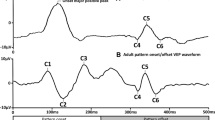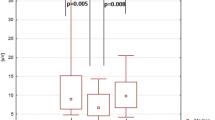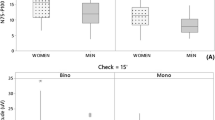Summary
We investigated the influence of eye dominance scaled by 6 tests on the parameters (N80, P100 latency and N80–P100 amplitude) of the white-black-, green-black-, red-black-and blue-black-pattern visual evoked potentials (PVEPs) of 40 healthy subjects (20 males and 20 females) with normal visual acuity. The P100 latency of the white-black PVEPs was, for both sexes, shorter (P ≤ 0.001) in the PVEPs of the dominant eyes. This P100 latency shortening could also be verified for both right dominant and left dominant eyes with no significant difference between them. A consistent relationship, however, between the different degrees of eye dominance and the P100 latency shortening could not be established. In contrast to the P100 latency findings the N80 latencies of the white-black-PVEPs and the N80-P100 amplitudes did not show any significant differences with respect to eye dominance. Furthermore, the colour-black PVEPs did not present any differences of latency and amplitude depending on eye dominance. Thus our results give further electrophysiological evidence for eye dominance as a lateralized CNS phenomenon that is not influenced by colour.
Similar content being viewed by others
References
Cobb WA, Morton HB, Ettlinger G (1967) Cerebral potentials evoked by pattern reversal and their suppression in visual rivalry. Nature 216:1123–1125
Coren S, Kaplan CP (1973) Patterns of ocular dominance. Am J Optom Physiol Opt 50:283–292
Crider B (1943) A battery of tests for the dominant eye. J Gen Physiol 31:179–190
Immich H (1974) Medizinische Statistik. Schattauer, Stuttgart New York
Lang J, Reiter W (1985) Über praktisch-ärztlich wichtige Maße des N. opticus, des Chiasma opticum und des Tractus opticus. Gegenbaurs Morphol Jahrb, 131:777–795
Narang HK (1977) Right-left asymmetry of myelin development in epiretinal portion of rabbit optic nerve. Nature 266:855–856
Nutzhorn H (1953) Untersuchungen zum Rechts-Links-Problem. Dissertation, Technische Hochschule, Braunschweig
Porac C, Coren S (1975) Is eye-dominance a part of generalized laterality? Percept Mot Skills 40:763–769
Porta (1593) de refractione
Seyal M, Sato S, White BG, Porter RJ (1981) Visual evoked potentials and eye dominance. Electroencephalogr Clin Neurophysiol 52:424–428
Taghavy A, Kügler CFA (1986a) Does eye-dominance influence the pattern reversal visual evoked potentials in man? Plügers Arch. 406 (Suppl): R7
Taghavy A, Kügler CFA (1986b) The effect of the three primary colours on the pattern reversal visual evoked potentials (PVEP). Pflügers Arch. 406 (Suppl): R16
Taghavy A, Lösslein H (1984) Sex differences in VEP and PVEP Electroencephalogr Clin Neurophysiol 58:93
Author information
Authors and Affiliations
Rights and permissions
About this article
Cite this article
Taghavy, A., Kügler, C.F.A. Pattern reversal visual evoked potentials (white-black- and colour-black-PVEPs) in the study of eye dominance. Eur Arch Psychiatr Neurol Sci 236, 329–332 (1987). https://doi.org/10.1007/BF00377421
Received:
Issue Date:
DOI: https://doi.org/10.1007/BF00377421




